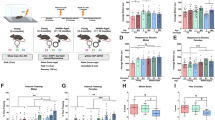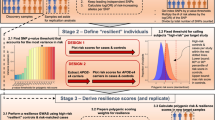Abstract
The apolipoprotein E (apoE) gene has been implicated in various conditions, most notably Alzheimer’s disease and coronary artery disease. A predisposing role of the apoE4 isoform and a protective role of apoE2 isoform in those diseases have been documented. Here we investigated the role of apoE in resilience to trauma. Three hundred and forty-three US veterans were genotyped for apoE and were assessed for their lifetime trauma exposure (trauma score, T) and severity of posttraumatic stress disorder symptoms (PCL). The ratio PCL/T indicates sensitivity to trauma; hence, its inverse indicates resilience, R, to trauma. We found a significantly higher resilience in participants with apoE genotype containing the E2 allele (E2/2, E2/3) as compared to participants with the E4 allele (E4/4, E4/3). In addition, when the categorical apoE genotype was reexpressed as the number of cysteine residues per apoE mole (CysR/mole), a highly significant positive association was found between resilience and CysR/mole, such that resilience was systematically higher as the number of CysR/mole increased, from zero CysR/mole in E4/4 to four CysR/mole in E2/2. These findings demonstrate the protective role of the CysR/mole apoE in resilience to trauma: the more CysR/mole, the higher the resilience. Thus, they are in accord with other findings pointing to a generally protective role of increasing number of CysR/mole (from E4/4 to E2/2) in other diseases. However, unlike other conditions (e.g., Alzheimer’s disease and coronary artery disease), resilience to trauma is not a disease but an adaptive response to trauma. Therefore, the effects of apoE seem to be more pervasive along the CysR/mole continuum, most probably reflecting underlying effects on brain synchronicity and its variability that we have documented previously (Leuthold et al., Exp Brain Res 226:525–536, 2013).






Similar content being viewed by others
References
Anand SS, Xie C, Paré G et al (2009) Genetic variants associated with myocardial infarction risk factors in over 8000 individuals from five ethnic groups: the INTERHEART genetics study. Circ Cardiovasc Genet 2:16–25
Bennet AM et al (2007) Association of apolipoprotein E genotypes with lipid levels and coronary risk. JAMA 298:1300–1311
Blake DD, Weathers FW, Nagy LN et al (1995) The development of a clinician-administered PTSD scale. J Traumat Stress 8:75–90
Blanchard E, Jones-Alexander J, Buckley TC, Forneris CA (1996) Psychometric properties of the PTSD checklist (PCL). Behav Res Therapy 34:669–673
Blom G (1958) Statistical estimates and transformed beta-variables. Wiley, New York
Bonanno GA, Mancini AD (2012) Beyond resilience and PTSD: mapping the heterogeneity of responses to potential trauma. Psychol Trauma 4:74–83
Box GEP, Cox DR (1964) An analysis of transformations. J R Stat Soc Lond Ser B Methodol 26:211–243
Breslau N, Kessler RC, Chilcoat HD, et al (1998) Trauma and posttraumatic stress disorder in the community: the 1996 Detroit Area Survey of Trauma. Arch Gen Psychiatr 55:626–632
Caselli RJ, Reiman EM, Osborne D et al (2004) Longitudinal changes in cognition and behavior in asymptomatic carriers of the APOE e4 allele. Neurology 62:1990–1995
Caselli RJ, Reiman EM, Locke DEC et al (2007) Cognitive domain decline in healthy apolipoprotein E ε4 homozygotes before the diagnosis of mild cognitive impairment. Arch Neurol 64:1306–1311
Christopoulos V, Georgopoulos A, Georgopoulos AP (2015) The effect of apolipoprotein E4 on synchronous neural interactions in brain cultures. Exp Brain Res 233:1977–1982
Conejero-Goldberg C, Gomar JJ, Bobes-Bascaran T, et al (2014) APOE2 enhances neuroprotection against Alzheimer’s disease through multiple molecular mechanisms. Mol Psychiatr 19:1243–1250
Corder E, Saunders A, Strittmatter W et al (1993) Gene dose of apolipoprotein E type 4 allele and the risk of Alzheimer’s disease in late onset families. Science 261:921–923
Corder EH, Woodbury MA, Volkmann I et al (2000) Density profiles of Alzheimer disease regional brain pathology for the Huddinge brain bank: pattern recognition emulates and expands upon Braak staging. Exp Gerontol 35:851–864
Farrer LA, Cupples LA, Haines JL et al (1997) Effects of age, sex, and ethnicity on the association between apolipoprotein E genotype and Alzheimer disease. JAMA 278:1349–1356
Feder A, Nestler EJ, Charney DS (2009) Psychobiology and molecular genetics of resilience. Nat Rev Neurosci 0:446–457
First MB, Spitzer RL, Gibbon M, Williams JBW (2002) Structured clinical interview for DSM-IV-TR axis I disorders, research version, non-patient edition (SCID-I/NP). Biometrics Research. New York State Psychiatric Institute, New York
Hatters DM, Peters-Libeu CA, Weisgraber KH (2006) Apolipoprotein E structure: insights into function. Trends Biochem Sci 31:445–454
James LM, Engdahl BE, Leuthold AC, Lewis SM, Van Kampen E, Georgopoulos AP (2013) Neural network modulation by trauma as a marker of resilience: differences between veterans with posttraumatic stress disorder and resilient controls. JAMA Psychiat 70:410–418
Kessler RC, Sonnega A, Bromet E (1995) Posttraumatic stress disorder in the National Comorbidity Survey. Arch Gen Psychiatr 52:1048–1060
King LA, King DW, Vogt DS, et al (2006) Deployment risk and resilience inventory: a collection of measures for studying deployment-related experiences of military personnel and veterans. Mil Psychol 18:89–120
Leuthold AC, Mahan MY, Stanwyck JJ et al (2013) The number of cysteine residues per mole in apolipoprotein E affects systematically synchronous neural interactions in women’s healthy brains. Exp Brain Res 226:525–536
Liu C-C, Kanekiyo T, Xu H, Bu G (2013) Apolipoprotein E and Alzheimer disease: risk, mechanisms and therapy. Nat Rev Neurol 9:184–184
Mahley RW (1988) Apolipoprotein E: cholesterol transport protein with expanding role in cell biology. Science 240:622–630
Mahley RW, Huang Y (2012) Apolipoprotein E sets the stage: response to injury triggers neuropathology. Neuron 76:871–885
Mahley RW, Rall SC (2000) Apolipoprotein E: far more than a lipid transport protein. Annu Rev Genom Hum Genet 1:507–537
Mahley RW, Weisgraber KH, Huang Y (2006) Apolipoprotein E4: a causative factor and therapeutic target in neuropathology, including Alzheimer’s disease. Proc Natl Acad Sci USA 103:5644–5651
Mahley RW, Weisgraber KH, Huang Y (2009) Apolipoprotein E: structure determines function, from atherosclerosis to Alzheimer’s disease to AIDS. J Lipid Res 50:183–188
Meaney MJ, Szyf M (2005) Environmental programming of stress responses through DNA methylation: life at the interface between a dynamic environment and a fixed genome. Dialogues Clin Neurosci 7:103–123
Pa J, Boxer A, Chao LL, et al (2009) Clinical-neuroimaging characteristics of dysexecutive mild cognitive impairment. Annals Neurol 65:414–423
Peterson CK, James LM, Anders SL et al (2015) The number of cysteine residues per mole in apolipoprotein e is associated with the severity of ptsd re-experiencing symptoms. J Neuropsychiatr Clin Neurosci 27:157–161
Russo SJ, Murrough JW, Han MH, Charney DS, Nestler EJ (2012) Neurobiology of resilience. Nat Neurosci 15:1475–84
Ward H, Mitrou PN, Bowman R et al (2009) APOE genotype, lipids, and coronary heart disease risk: a prospective population study. Arch Intern Med 169:1424–1429
Weisgraber KH, Rall SC, Mahley RW (1981) Human E apoprotein heterogeneity. Cysteine-arginine interchanges in the amino acid sequence of the apo-E isoforms. J Biol Chem 256:9077–9083
Windle G, Bennett KM, Noyes J (2011) A methodological review of resilience measurement scales. Health Qual Life Outcomes 9:8
Zannis VI, Just PW, Breslow JL (1981) Human apolipoprotein E isoprotein subclasses are genetically determined. Am J Human Genet 33:11–24
Zannis VI, Breslow JL, Utermann G et al (1982) Proposed nomenclature of apoE isoproteins, apoE genotypes, and phenotypes. J Lipid Res 23:911–914
Zhou W et al (2008) Meta-analysis of APOE4 allele and outcome after traumatic brain injury. J Neurotrauma 25:279–290
Acknowledgements
This study was supported in part by the US Department of Veterans Affairs and the University of Minnesota. The contents of this paper do not represent the views of the US Department of Veterans Affairs or the United States Government.
Author information
Authors and Affiliations
Corresponding author
Rights and permissions
About this article
Cite this article
James, L.M., Engdahl, B.E. & Georgopoulos, A.P. Apolipoprotein E: the resilience gene. Exp Brain Res 235, 1853–1859 (2017). https://doi.org/10.1007/s00221-017-4941-4
Received:
Accepted:
Published:
Issue Date:
DOI: https://doi.org/10.1007/s00221-017-4941-4




